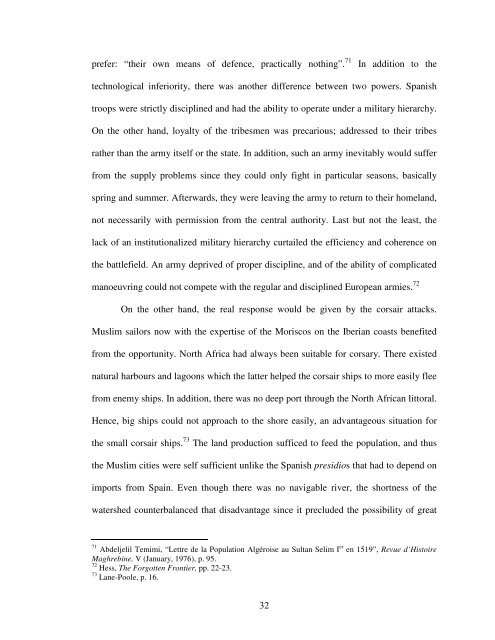OTTOMAN CORSAIRS IN THE WESTERN ... - Bilkent University
OTTOMAN CORSAIRS IN THE WESTERN ... - Bilkent University
OTTOMAN CORSAIRS IN THE WESTERN ... - Bilkent University
You also want an ePaper? Increase the reach of your titles
YUMPU automatically turns print PDFs into web optimized ePapers that Google loves.
prefer: “their own means of defence, practically nothing”. 71 In addition to the<br />
technological inferiority, there was another difference between two powers. Spanish<br />
troops were strictly disciplined and had the ability to operate under a military hierarchy.<br />
On the other hand, loyalty of the tribesmen was precarious; addressed to their tribes<br />
rather than the army itself or the state. In addition, such an army inevitably would suffer<br />
from the supply problems since they could only fight in particular seasons, basically<br />
spring and summer. Afterwards, they were leaving the army to return to their homeland,<br />
not necessarily with permission from the central authority. Last but not the least, the<br />
lack of an institutionalized military hierarchy curtailed the efficiency and coherence on<br />
the battlefield. An army deprived of proper discipline, and of the ability of complicated<br />
manoeuvring could not compete with the regular and disciplined European armies. 72<br />
On the other hand, the real response would be given by the corsair attacks.<br />
Muslim sailors now with the expertise of the Moriscos on the Iberian coasts benefited<br />
from the opportunity. North Africa had always been suitable for corsary. There existed<br />
natural harbours and lagoons which the latter helped the corsair ships to more easily flee<br />
from enemy ships. In addition, there was no deep port through the North African littoral.<br />
Hence, big ships could not approach to the shore easily, an advantageous situation for<br />
the small corsair ships. 73 The land production sufficed to feed the population, and thus<br />
the Muslim cities were self sufficient unlike the Spanish presidios that had to depend on<br />
imports from Spain. Even though there was no navigable river, the shortness of the<br />
watershed counterbalanced that disadvantage since it precluded the possibility of great<br />
71 Abdeljelil Temimi, “Lettre de la Population Algéroise au Sultan Selim I er en 1519”, Revue d’Histoire<br />
Maghrebine, V (January, 1976), p. 95.<br />
72 Hess, The Forgotten Frontier, pp. 22-23.<br />
73 Lane-Poole, p. 16.<br />
32

















